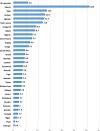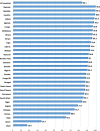Sexual autonomy and self-reported sexually transmitted infections among women in sexual unions
- PMID: 35081983
- PMCID: PMC8790891
- DOI: 10.1186/s13690-022-00796-4
Sexual autonomy and self-reported sexually transmitted infections among women in sexual unions
Abstract
Background: Sexually transmitted infections (STIs) are major public health challenges worldwide. Despite the importance of sexual autonomy in the prevention and control of sexual and reproductive health disorders such as STIs, there are limited studies on the possible relationship between women's sexual autonomy and self-reported STIs, especially in sub-Saharan Africa (SSA). This study, therefore, examined the association between sexual autonomy and self-reported STIs among women in sexual unions in SSA.
Methods: Data from the Demographic and Health Survey (DHS) of 31 countries in SSA conducted between 2010 and 2019 were analysed. A total of 234,310 women in sexual unions were included in the study. Data were analysed using binary logistic regression models and the results were presented as crude odds ratios (cORs) and adjusted odds ratios (aORs) at 95% confidence interval (CI).
Results: The prevalence of self-reported STIs among women in sexual unions in SSA was 5.8%. Approximately 83.0% of the women surveyed had sexual autonomy. Women who had no sexual autonomy were less likely to have self-reported STIs (cOR=0.52, CI: 0.46-0.54), compared to those who had sexual autonomy. Additionally, higher odds of self-reported STIs were found among women aged 25-29, compared to those aged 15-19 (aOR= 1.21, CI: 1.09-1.35); those who reside in urban areas, compared to those who reside in rural areas (aOR= 1.51, CI: 1.37-1.66) and those who were cohabiting, compared to those who were married (aOR= 1.65, CI: 1.52-1.79). On the other hand, lower odds of self-reported STIs were found among women who were exposed to newspapers (aOR= 0.89, CI: 0.82-0.95), those whose partners had primary education (aOR= 0.84, CI: 0.78-0.91), those who were not exposed to radio (aOR= 0.84, CI: 0.79-0.89), and working women (aOR= 0.86, CI: 0.80-0.93).
Conclusions: Findings from this study suggest that sexual autonomy is a significant predictor of self-reported STIs among women in sexual unions in SSA. Thus, instituting policies and programs that empower women and improve their levels of sexual autonomy may result in increased self-reporting of symptoms associated with STIs which subsequently help in minimising STI-related complications. Also, policies aimed at enhancing women's sexual autonomy may reduce the burden of STIs in SSA, especially among women in sexual unions.
Keywords: Public health; STIs; Sexual autonomy; Sub-Saharan Africa; Women.
© 2022. The Author(s).
Conflict of interest statement
The authors declare that they have no competing interests.
Figures
Similar articles
-
A multi-country cross-sectional study of self-reported sexually transmitted infections among sexually active men in sub-Saharan Africa.BMC Public Health. 2020 Dec 7;20(1):1884. doi: 10.1186/s12889-020-09996-5. BMC Public Health. 2020. PMID: 33287785 Free PMC article.
-
Sexual violence and self-reported sexually transmitted infections among women in sub-Saharan Africa.J Biosoc Sci. 2023 Mar;55(2):292-305. doi: 10.1017/S0021932022000062. Epub 2022 Feb 23. J Biosoc Sci. 2023. PMID: 35193714
-
Self-reported sexually transmitted infections among adolescent girls and young women in sub-Saharan Africa.Int Health. 2022 Nov 1;14(6):545-553. doi: 10.1093/inthealth/ihab088. Int Health. 2022. PMID: 35134172 Free PMC article.
-
Provincial distribution and factors associated with self-reported sexually transmitted infections and their symptoms among women in Sierra Leone.BMC Infect Dis. 2024 Nov 8;24(1):1265. doi: 10.1186/s12879-024-10030-x. BMC Infect Dis. 2024. PMID: 39516716 Free PMC article.
-
Sexually transmitted infections in pregnant women from sub-Saharan Africa.S Afr J Infect Dis. 2021 Dec 9;36(1):312. doi: 10.4102/sajid.v36i1.312. eCollection 2021. S Afr J Infect Dis. 2021. PMID: 34917679 Free PMC article. Review.
Cited by
-
Self-reported sexually transmitted infections among adolescent girls and young women in Mali: analysis of prevalence and predictors.BMJ Open. 2023 Apr 24;13(4):e069226. doi: 10.1136/bmjopen-2022-069226. BMJ Open. 2023. PMID: 37094889 Free PMC article.
-
Self-reported sexually transmitted infections among men and women in Papua New Guinea: A cross-sectional study.Health Sci Rep. 2024 Mar 27;7(3):e1970. doi: 10.1002/hsr2.1970. eCollection 2024 Mar. Health Sci Rep. 2024. PMID: 38545430 Free PMC article.
-
Women's and girls' sexual empowerment differs by geographical context: a population-based validation study.BMC Womens Health. 2025 Jul 5;25(1):331. doi: 10.1186/s12905-025-03874-1. BMC Womens Health. 2025. PMID: 40618041 Free PMC article.
-
Gynecological morbidity and treatment-seeking among older adult (aged 45-59) women in India.Reprod Health. 2023 Apr 27;20(1):64. doi: 10.1186/s12978-023-01611-1. Reprod Health. 2023. PMID: 37106377 Free PMC article.
-
Educational interventions to improve women's preventive behavior of sexually transmitted infections (STIs): study protocol for a randomized controlled trial.Trials. 2022 Sep 2;23(1):724. doi: 10.1186/s13063-022-06663-5. Trials. 2022. PMID: 36056379 Free PMC article.
References
-
- Arakkal GK, Damarla SV, Kasetty HK, Chintagunta S. R. Changing trends in sexually transmitted infection (STI) clinic attendees–Current scenario. Int J Med Sci Public Health. 2014;3(10):1215–18. doi: 10.5455/ijmsph.2014.260620141. - DOI
-
- Newman L, Rowley J, Vander Hoorn S, Wijesooriya NS, Unemo M, Low N, Temmerman M. Global estimates of the prevalence and incidence of four curable sexually transmitted infections in 2012 based on systematic review and global reporting. PloS one. 2015;10(12):e0143304. doi: 10.1371/journal.pone.0143304. - DOI - PMC - PubMed
LinkOut - more resources
Full Text Sources
Research Materials



